When I began collecting political items in the late sixties, I lived in Montana which was insulated from the organized political collecting world. Without a senior mentor, my only source of information on collecting was initially Dick Bristow’s, Illustrated Political Button Book and later Tom French’s periodical, The Political Collector. I recall one reference proclaiming in essence that it was only the content on the front of the button that mattered not the paper in the back. At the time this didn’t sit well with me and has since sparked a separate outlet and passion in my collecting, acquiring buttons manufactured by obscure manufacturers with a special interest in those located in the western United States.
Initially, I used backpapers as a bellwether for a button’s authenticity, a security blanket against the dreaded reproduction. Unfortunately, this isn’t such a shield anymore with the repins sporting later backpapers by Torch and Franz and St. Louis Button Company turning up more frequently on the market of late. Understanding the subtle differences in backpapers over time is quite useful in sorting out items of questionable authenticity and dating items from candidates that ran on more than one occasion. Ted Hake gives an excellent presentation of manufactures and different backpapers used through the years by some of the major companies in the suffix of his book, Collectible Pin-Back Buttons 1896-1986. I strongly recommend everyone obtain a copy as it is an invaluable reference. I hope this article will provide an adjunct to his work and look more closely at button makers operating in the first half of the twentieth century or earlier in the western United States.
Growing up in Montana, most of the celluloids I encountered were either “Pin-lock” filled back buttons or carried a Whitehead and Hoag backpaper. Whitehead and Hoag must have had a huge market share in the state; in fact, they had an office in Butte through much of the 1920’s. As my collecting interests grew, I found myself drawn to the pins that rarely blessed the pages of mail order auctions rather than the beautiful classics which seemed to appear regularly. It seemed these pins were more often produced by less known manufacturers; therefore, fueling my interest in collecting items from these “regional” shops. Don’t get me wrong, I still like the classics but I get a special joy from obtaining the often less graphic but less plentiful pins made by obscure companies. In this article I will present the manufacturers I could document from the states of: California, Oregon, Washington, Utah, Colorado and Montana. I could not find any manufacturers in Wyoming, Arizona, Idaho and New Mexico in operation and producing campaign buttons prior to 1950. Also of interest, I have yet to find any pins made by western manufacturers for either Parker or Cox. Certainly there are so few Cox variations that this is not particularly surprising but the nominating convention was in San Francisco and Colorado Badge made a simple Harding that I suspect may have a mate. Parker on the other hand has many designs but the overwhelming majority are from mated sets by Whitehead and Hoag or Baltimore Badge. I supect a bigger factor was his lack of popularity out west. He garnered less than 20% of the vote in Washington and Oregon and only 26% in California. If any of you find any pinbacks produced out west for either of these candidates please reach out and share them with me.
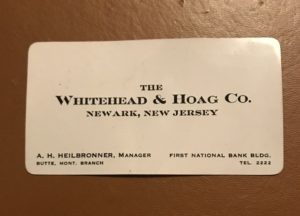
California
We will start with California the largest western state and home to a number of button manufacturers responsible for many great pinbacks. The most prolific and well known California button maker was the Walter N. Brunt Company of San Francisco. The earliest reference I could find of the company’s operation is a patent application to produce “badges” in 1894. The company relocated on many occasions and the date of a pin’s production can be inferred by the address cited on the pin’s backpaper ( see table below). The first address on celluloids is 535 Clay St. which changed to 535-537 Clay St. in 1901 and then again in 1904 when they moved to 102-104 2nd St. Â The great earthquake and fire destroyed that building in 1906 and they reopened at a temporary location at 391 Jesse St. in 1907 and relocated to 860 Mission St in 1909. They remained there until 1910 when their address changed to 878-880 Mission St, though I have only seen backpapers with the 880 address. The style of the backpaper changed from simple printing (see photo of 860 backpaper) to the modern design (see 880 and 7th St photos) in approximately 1916. From 1919 to 1921 they used a 766 Mission address. 111 7th St. was then their business address through the remainder of their production. The latest pinbacks I am aware of at this address are from the 1940 election. Sadly, this research proved that one of my early acquisitions, a unique photo pin of McKinley, must have been a commemorative item because it carries a 860 Mission backpaper which would indicate a production date after 1909. A very rare gold TR rebus pin carries an 880 Mission paper which would suggest a 1911 or later manufacture despite a younger photo. There is a TR pin in his rough rider uniform on eBay which carries a 766 Mission backpaper implying distribution between 1919 and 1921; it may have used re-pinned papers for a later event or they may have purchased “new old stock” and put their papers over the Whitehead and Hoag papers usually associated with this item–I would love the opportunity to check for myself. I have a Wilson pin with a 766 address which would imply was made for the 1919 League of Nations west coast tour in 1919 or for the 1920 Democratic Convention. An enigma in attribution is the Harding “West Coast Tour” pin which is frequently ascribed to Brunt. The vast majority I have seen (including a sizable hoard) are usually devoid of backpaper. The ones I have seen with Brunt papers carry the 880 Mission address suggesting they continued to use papers after relocating until the supply was exhausted. I have also seen one of these pins with a Donaldson backpaper. They were a San Francisco company which produced some labor pins in the early 1920’s but I have not seen any other presidentials with their label. JC Irvine in 1886 at 751 Market and made a graphic 11/4″ celluloid, a wonderful jugate and a strange brass relief pinback with a collet both for the 1904 Theodore Roosevelt campaign. They were destroyed in the great fire and reopened at 2129 Market as Irvine, Wirth and Jachens and I have seen a Fighting Bob Evans pin with that backpaper. They subsequently became Irvine and Jachens which produced a number of presidential pins for Wilson and at least one for Debs. In addition, their backpaper appears in a litho for Hoover. In my opinion this is a 1920 hopeful given its slogan, the address of the company, 1027 Market as they moved to Mission St. in 1926, and its construction is more akin to those from the J. L. Lynch Company rather than those produced in later years by Green Duck. They moved to Daly City in around 1950 and are known primarily as makers of law enforcement badges. San Francisco is also represented by the Pasquale Company which contributed the Roosevelt/Fairbanks California Bear jugate, Moise-Klinkner which made a badge for Hoover’s notification at Stanford University and Russell Wisler Printing known from local items from 1910’s. Star Engraving on Minnesota St. produced pins from the mid-30’s to the 1960’s but the only presidential I am familiar with is a 7/8″ Stevenson marked on the curl. Howard Usher turned up a backpaper that was new to me, A.H. Hendler and Co., which was on a commemorative likely from 1905-1920. Received a photo of a pinback for a local San Francisco measure from the late 1930’s made by Derbon Press on 2nd St but haven’t seen any other items by this maker. Ferry Bros. made pins for the Pan Pacific Exposition in 1915 and were located on Van Ness but I have not seen any politicals; I think the Wilson from that Exposition is a Whitehead and Hoag but sadly I don’t own one to confirm. A pin promoting San Jose in 1914 made by Quincy Calglesser turned up on Facebook. He, Mr. Calglesser, lived in Santa Clara and is listed in the Commercial Stamp Trade Journal in 1909 with a San Jose address. Joseph Schwalbe and Co. at 512-514 Market St in San Francisco made buttons to commemorate Spanish American War veterans prior to 1900. I have not seen any other pins by them. Willkie pins made by Golden Gate Press were recently posted on facebook, but I have been unable to find any information on this maker. I recently acquired a 7/8″ Stevenson word pin made by Olivier Printing Co. on 4th St in San Francisco; does anyone have anything else by this maker?
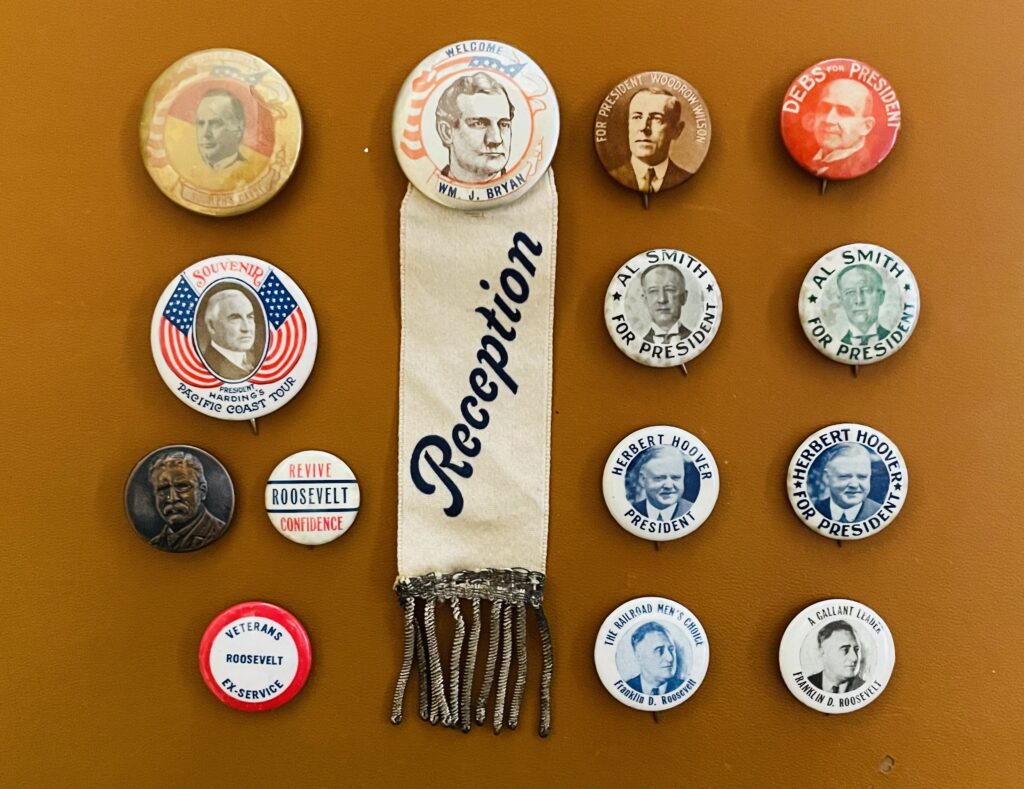
Pins from Brunt, JC Irvine and Irvine and Jachens

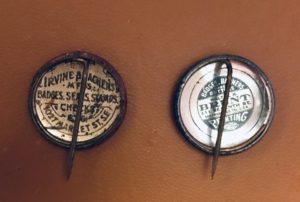
Lithographs marked by Irvine and Jachens and Walter Brunt but likely manufactured by Lynch and Green Duck
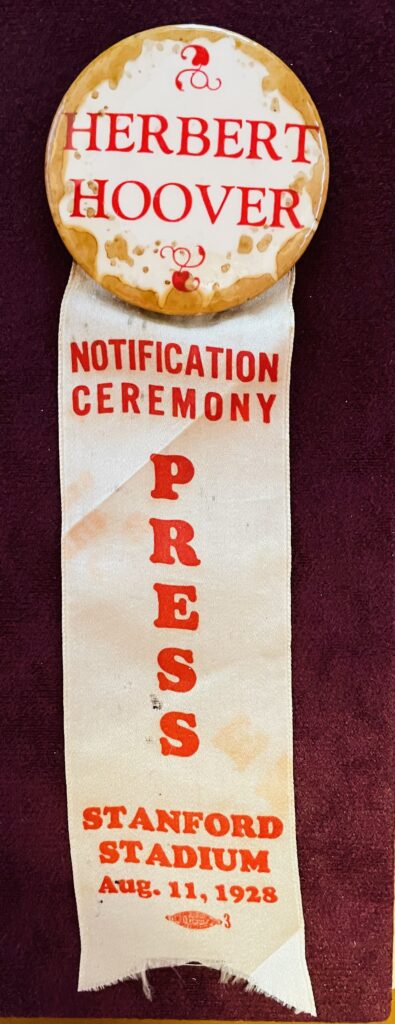
Badge made by Moise-Klinkner
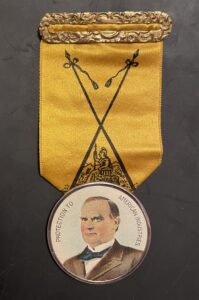 Â Â Â
   
Colorful badge by Pasquale and Sons
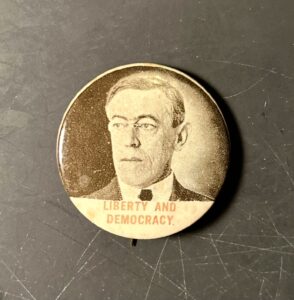
Brunt pin with 766 Mission St address indicating manufacture 1919-1921
Los Angeles is well represented by button producers. Hoegee made some graphic pins to include “Teddy’s Terrors.” Their pins seem to be limited to the early 1900’s extending into the teens; they made multiple variations of the black on yellow “Votes for Women” pins. LA Badge and Manufacturing Company made pins for Taft’s visit in 1911 but also made the 7/8″ Roosevelt/Johnson California jugate. LA Rubber Stamp Co. began in the 1880’s making badges for law enforcement organizations. In the early 1920’s they changed their name to LA Stamp and Stat Co. They went out of business in 1964 and their inventory was sold at auction. They have a negative internet profile because their inventory was refashioned into law enforcement badges and sold as originals. Law enforcement badge collectors are very suspect of items produced by this company. In addition to police badges, they did produce celluloid pinbacks; I have examples of pins for Wilson and Coolidge. Given the company changed its name after his death, I suspected the Wilson pin was a prop for the 1944 movie about his life; I subsequently watched the movie online and confirmed my suspicion. Western Badge not to be confused with the St. Paul maker with a very similar name produced a number of presidential pins. The earliest I could find is a 1 1/4″ TR with an unusual design but examples are available at least through the 1964 election. Heritage listed a single day event pin from 1917 picturing Woodrow Wilson with a Kellow and Brown Novelty backpaper. I could find nothing earlier than 1915 on the company and nothing after 1918 but have seen a patriotic flag pin which likely is a WWI homefront piece.

Pins from Hoegee, LA Rubber Stamp, LA Stamp and Stationary, Western Badge and Pasquale
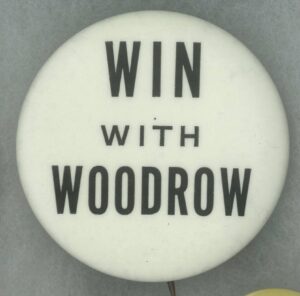
Pin made by LA Stamp and Stationary in 1940 for Wilson Hollywood Movie
Oregon
I initially could identify only two companies manufacturing campaign pins in Oregon in the first half of the century. Pacific Regalia in Portland produced items starting with the 1896 election and I have found no items documented after 1904. Apparently, they went out of business shortly after losing the contract to supply pins for the Lewis and Clark Exposition to a “large firm from New Jersey.” Despite their short longevity they were quite prolific and had some very distinctive designs, not the least of which is in my opinion the best button made in the west ”the Uncle Sam McKinley/Roosevelt Bicycle jugate.” This company’s backpapers are found on a number of pins known to be produced by larger manufacturers, suggesting they distributed already manufactured pins or produced pins with acquired artwork. There are examples of all the 7/8″ 1896 Whitehead and Hoag jugates with Pacific Regalia papers and the ubiquitous sepia TR/Fairbanks which usually comes with a filled back. Portland is also home to the Irwin-Hodson Company whose distinctive red on white backpapers first appeared on a Taft pin and can be found on items through the 1960 election. The company is still in business but produces predominantly business signage. Their most prized pin is likely the 6″ Hughes name pin; all northwest collectors dream of finding one in an antique mall or flea market and still speak of the one found out on the coast. Recently came across a pin advocating Gresham joining Portland made by “American Badgemakers Company”, since the city was incorporated in 1906 I suspect this pin to be of that vintage.

Pinbacks from Pacific Regalia and Irwin-Hodson
Washington
Washington was home to a plethora of companies that produced pinbacks; most were obscure and had very few if any presidential items associated with them. The exception is the Grays Harbor Stamp Works in Aberdeen which opened its doors in 1916 but began making pinbacks in 1937. The last presidential item I could unambiguously attribute to G.H. Stamp is a a Clinton Lowery coat tail pin. They were also the likely source of the FDR pair with the “Designed and Distributed by Edw F Murray Seattle” backpaper as they have an Aberdeen union bug. Their most sought after items are likely the Truman “Washington Club” and the “Washington for Dewey”, which though very non-descript are exceedingly rare (an example was recently available in a USAmericana Auction). Seattle was home to a number of button manufacturers but examples of their work are limited. F.M.Webb & Co produced pins for Teddy Roosevelt’s visit in 1903 and likely pins for the 1904 election but I know of only 2 Roosevelt varieties, two pins for local candidates and some non-political pins made by this company. The founder Frederick M. Webb had worked at Pacific Regalia in Portland before opening his own shop in 1902. No listings in city directories are present after 1903 when he and the Mrs. apparently had a nasty parting of ways. Lowman and Hanford printing opened in 1894 and was in business until 1955. I have not seen a political pin with this company’s mark but have seen a colorful fraternal organization pinback from the first decade of the last century with their marking on the curl and and advertising button for a cattle company with an interesting backpaper pictured below. They may be the source of some of the orphans discussed below. Dukinfield Printing opened in the early 1900’s but the only pins marked with their logo date to the 1930’s. I am aware of an FDR, a Landon, a Harvey, and great Hoover oval and a department store Santa pin. They didn’t use backpapers and printed directly on the metal back usually with poor results. This is why when described in auction catalogs their name is often misspelled sometimes to the point it is unrecognizable. I suspect they are a more likely source of some the unidentified pins of the northwest. The only pins known to be produced by Bill’s Buttons are the crudely made FDR pins made in the style of wartime employee badges with multiple different colored rims; the one pictured has FDR stamped across the artwork but most do not. Bull Brothers also produced pins during the teens but I know of only one senate item in the political genera. The internet turned up another Seattle maker, Sheppard Celluloid Novelties, which was found on a pin for a local candidate and carried a Seattle bug with 44 designation. I recently obtained an unusual Dewey pin made by Pacific Coast Stamp Works in Seattle. I found a catalog from 1915 for this company on line but have no idea when they produced pinbacks. Tacoma was home to Pacific Stamp Works which made beautiful sepia as well as black and white pins at the turn of the last century but I only seen one political campaign item bearing their backpaper, a 1 3/4″ tinted sepia TR. Spokane was home to two manufacturers: Spokane Stamp Works and Inland Printing. I have not seen any politicals from the former but the latter produced the Taft visit pin, a TR pin with an unusal photo and a Wilson which is easily confused with a common Whitehead and Hoag design but for a subtle font difference. They may also be responsible for the “My Hat is in the Ring…I’ll Beat Them to a Frazzle” TR pin discussed in another article on this site.
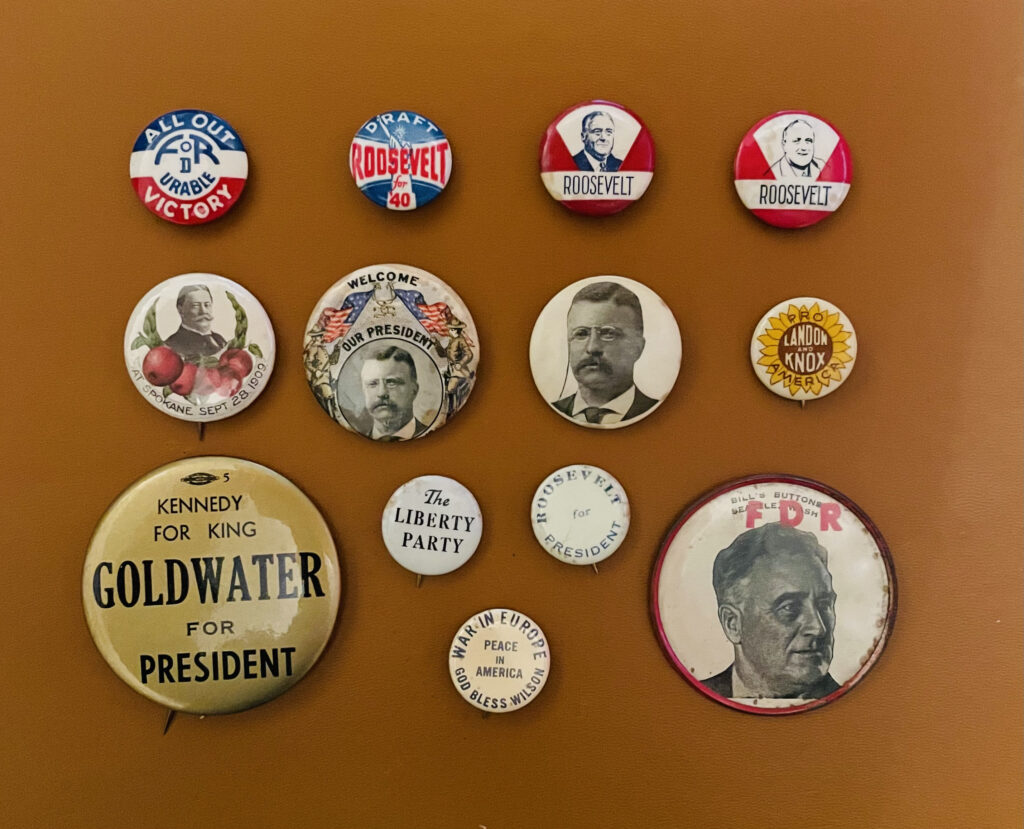
Gray’s Harbor Stamp Works, FM Webb, Inland Printing, Dukenfield and Bill’s Buttons
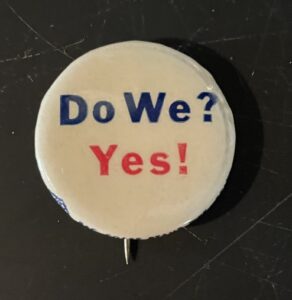
Pacific Coast Stamp Works
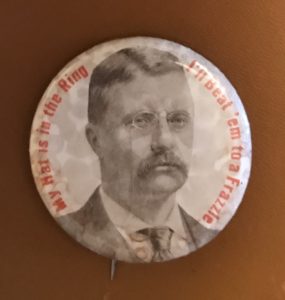
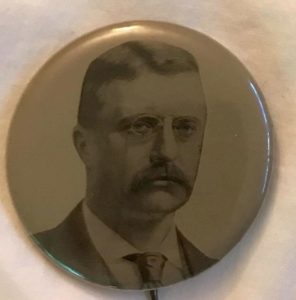
Bottom Pin made by Inland Printing in Spokane and I suspect the “Frazzle” pin was made there as well
Colorado, Utah and Montana
Colorado is represented by one company with an extended history and portfolio and five smaller companies with limited political material. Colorado Badge and Novelty produced memorabilia from at least 1907 through 1940. The earliest political piece I could find is a metal broom for one of the Carey campaigns in Wyoming (unclear if it was produced for Robert or Joseph). Celluloid pins are known for Harding, Hoover, Smith, Willkie and FDR. Pueblo is known to have had three button makers. I am unaware of any presidential pins made by either Pueblo Lithographers or Franklin Printing, but H.S. Stovall made a very nice sepia Bryan pin for the 1908 election with the slogan around his portrait “Let the People Rule.” I have seen a pair of Bryan and McKinley portrait pins with very unusual slogans from the 1900 campaign with an H.S. Stovall backpaper from Weatherby MO suggesting they relocated to Colorado early in the twentieth century. Pueblo is also home to J. Corry Baker Badges Buttons and Advertising Novelties which made a very nice 1 3/4″ Taft pin for the Big State Fair at Pueblo. One of the finest presidential pins to come out of the west is the Bryan 1 ½” with his picture above the map of the United States. It was produced by the Western Button Company of Denver and has ordering information on its backpaper; 15 cents each with a mailing address in Villa Park Colorado. An IKE pin was recently published in a national auction with WIDOICO Inc. on the curl but an internet search turned up nothing. A Lindbergh pin recently turned up on the internet made by Callman Novelty Co. of Denver. Of interest, this pin had a very thick and flat collet similar to white backed reproductions. Hawes Photography and its subsidiary the Montana Button House as well as the Bessette-Storr all were located in Butte Montana and produced buttons in Montana in the early 1900’s. They produced a couple of different celluloid pins supporting William Clark’s candidacy for the US Senate in 1900 and a McKinley sepia which was likely a mourning item and the latter a labor pin supporting McNamara. The only other pinbacks I know that were manufactured in Montana were commissioned by Marcus Daly for the 1894 election to determine the state capital. They were made by Leys or Leyson Jewelry in Butte in support of Anaconda. I have eight different varieties and they exist in both brass and enameled varieties. The enamel come in at least 6 color combinations. Utah is known for three companies. The first of which, US Spec and MFG in Salt Lake, produced at least one presidential pin a sepia picture pin for Wilson likely from either his 1916 election or 1919 tour in support of the League of Nations. More widely known in the hobby is the Salt Lake Stamp Co. which produced celluloids in the 30’s and 40’s. I know of pins produced for Willkie, Harvey of the Liberty Party and of course the FDR/Blood jugate. Lastly, Art Novelty Co. of Salt Lake produced at least one presidential pinback, a non-descript Wilson 7/8″.

Colorado Badge, US Spec, Hawes, Bessette-Storr, Art Novelty and Salt Lake Stamp

Ley’s Jewelers enamel pins from Capital Campaign
Orphans
There are a number of pinbacks that northwest collectors presume were manufactured in either Washington or Oregon. Some of these carry Portland or Seattle union bugs but no manufacturer. One of these, the 1912 Washington Progressive Convention pin, is very similar in color scheme and the unusual pinback used to the Taft Alaska Yukon Expo pin so I have always assumed they were made in the same shop. Many are completely unmarked such as the “God Bless America” FDR and Willkie pins. Strangely, Oregon collectors often attribute them to Washington and Washington collectors to Oregon; truly orphans. I had always thought they were unlabeled Irwin-Hodson products. Others I have no idea as to their origin such as the Spokane Taft which is a filled back with no celluloid cover, the King County Hughes and the Wilson “Welcome to Our City” which is likely from his 1919 visit to Seattle. If anyone has any information about the origins on these items please let me know.
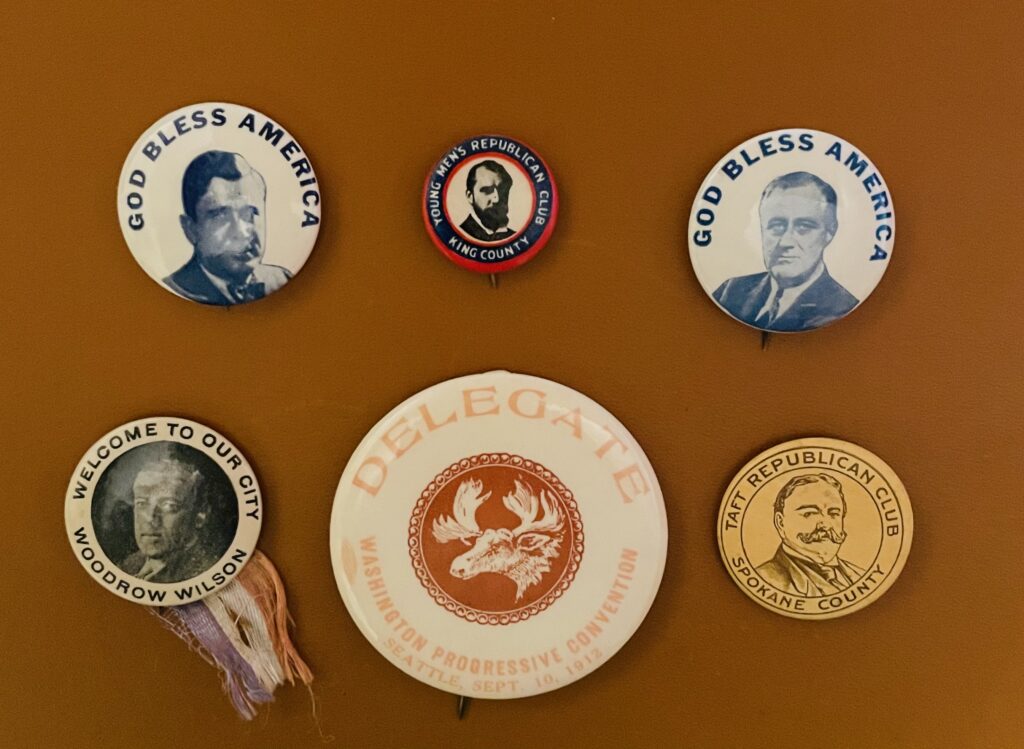
Unknown manufacturers felt to originate in the Northwest
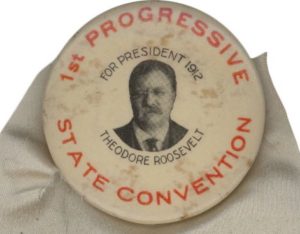
Another pinback I believe was manufactured in Seattle given the construction and color scheme
Certainly my backpaper obsession is atypical in our hobby, but I would rather have the same pin with an obscure paper than one produced by Whitehead and Hoag, Bastian Brothers or St. Louis Button Co. In an age where old repins with backpapers have been appearing with increasing regularity getting to know what’s on the back can be as important as the graphics on the front. I would like to thank the late Tom Berg for his assistance with Colorado makers, Tom French with the bay area companies and Ted Hake for his insight and keen eye. If I have left out any of your favorites, I would be happy to hear about them.
I am always interested in purchasing presidential items made by western manufacturers. Text photos to (406)217-2017 or contact us with the link above.
Brunt Addresses and Dates of Operation:
535 Clay St. prior to 1901
535-537 Clay St. 1901-1904
102-104 2nd St. 1905-1906(earthquake)
391 Jesse St. 1907-1909
860 Mission St. 1909-1910
878 or 880 Mission St. 1910-1919
766 Mission St. 1919-1921
111 7th St. post 1921

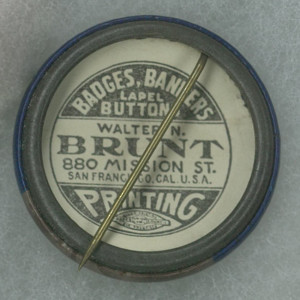
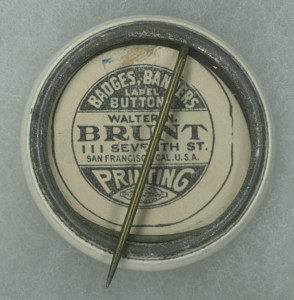
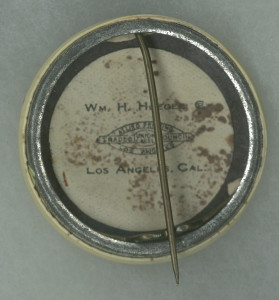
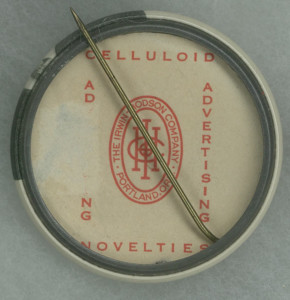
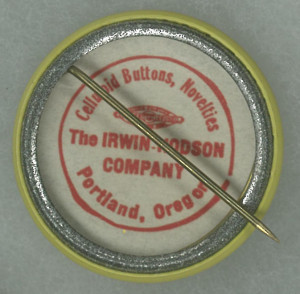
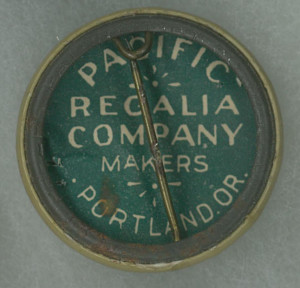

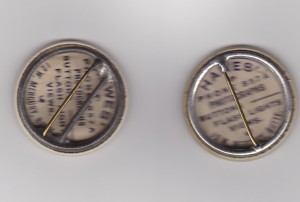
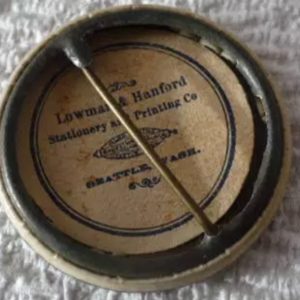
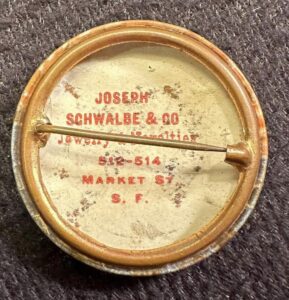
Examples of backs from western button makers

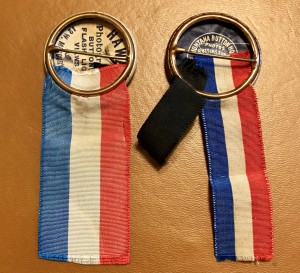
Same pin made by Hawes and its subsidiary Montana Button House
fifa
September 14, 2016 at 11:47 amYou’re an extremely useful internet site; could not make it without ya!
fifa http://bb-u.de/cheapnba2k17coins277247
corburterilio
January 16, 2017 at 9:26 pmHey very nice blog!! Man .. Excellent .. Amazing .. I’ll bookmark your website and take the feeds also…I’m happy to find so many useful info here in the post, we need work out more techniques in this regard, thanks for sharing. . . . . .